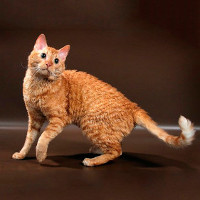 |
Ural rex |
|
TranslationFrancis Vandersteen |
||
OriginThe Ural rex or Ural Rex is a breed of cat originating from Russia. |
| This cat is characterized by its short to medium-length curly coat. |
Standard |
| The World Cat Federation is the only major federation to recognize the Ural rex. |
A brief historical overview |
| The Ural rex has been known in Russia since the Second World War, but the political retreat of the USSR prevented the breed from developing in Europe and America. It was not until the glasnost era that the breed became known in the West, in much the same way as the Kuril Bobtail or the Sibérien. The breed's founder is a two-tone black male named Vasilly, born in 1988 in Zaretchny. In order to fix the curly gene, several inbred crosses were carried out. These crosses showed that the Ural rex is a well-built breed, free from hereditary disease. However, to ensure a sufficient genetic pool, inbreeding with Europeans was authorized. The first Ural rex breedings were concentrated in Yekaterinburg, in the “Ural rex”, “fairy tales” and “Emerald” catteries, before being exported to Moscow in 1997. The name Ural rex refers to the breed's region of origin, the Urals, and to the fact that it is a rex cat. The Ural rex was recognized by the WCF in August 2006. The first imports outside Russia took place in June 2007 in Germany: German lines are developed from a female “Dorothea Uralochka” and her half-brothers “Dimka” and “Eroshka Uralochka”; the first litters were registered in 2008 and 2009. |
Head |
||
Cranial region |
||
Head |
The head is shaped like a short wedge, with the cheek bone rather prominent. | |
Facial region |
||
Forehead |
Flat forehead. | |
Muzzle |
The muzzle is slightly curved at the level of the lower eyelids. | |
Cheeks |
The cheek bones are pronounced with a distinct pinch. | |
Eyes |
Large, oval-shaped eyes set wide apart; their color should match that of the coat. | |
Ears |
Medium-sized ears set high on the head, with rounded tips. | |
Body |
||
Generality |
Medium-sized, muscular and relatively short. | |
Tail |
| The fine tail is of medium length. |
Limbs |
| The legs are proportionate to the body, slender and ending in oval paws. | ||
Forequarters |
Hindquarters |
Coat |
||
Coat and texture |
The coat is short to medium-length, silky and dense. It undulates over the entire body and tail. The waves should be elastic. | |
Color and ticking |
All traditional colors are accepted. The pattern is tabby, solid or two-tone. The ticked tabby pattern is forbidden, as is sepia. | |
Authorized marriages |
| Marriages were permitted with the European until December 31, 2011. |






 English (United Kingdom)
English (United Kingdom)